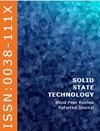Design and analysis of alcohol gas sensors using nano particles for micro heaters
Q4 Materials Science
引用次数: 0
Abstract
This research describes simulation of MEMS-based Alcohol Gas Sensor study of nanoparticles coated with various parameters such as power consumption, temperature uniformity, change in resistance, sensitivity and selectivity. This is done by calculating the resistance changes as gas is spread over the sensing layer. This instant response in gas detection helps in various applications such as vehicle breath analyser, breath analyzer, food quality control, etc. The gas sensor uses a micro-hotplate structure made of poly silicone mesh. The sensor holds a very thin conductive titanium film which detects the existence of vapors of ethyl alcohol on it. The temperature produced by the hot-plate influences different factors, such as the film's conductance and the amount of a particular gas adsorbed thereon. When the sensor film is brought to the right boiling point temperature, the residual vapor particles evaporate. We configure the supply voltage (around 3 volts) and evaluate the microheater's uniform temperature profile (619.29 K) along with sensitivity and selectivity for efficient sensing of alcohol gas. For the analysis of gas sensing, we have to equate the sensitivity of ZnO, TiO2 and SnO thin film coating. The concept was implemented using heating joules, thermal expansion and FEM simulation with electric current.微型加热器用纳米颗粒酒精气体传感器的设计与分析
本研究描述了基于MEMS的酒精气体传感器的模拟研究,研究了涂覆有各种参数的纳米颗粒,如功耗、温度均匀性、电阻变化、灵敏度和选择性。这是通过计算气体在传感层上扩散时的电阻变化来实现的。这种气体检测的即时响应有助于各种应用,如车辆呼吸分析仪、呼吸分析仪、食品质量控制等。气体传感器使用由多晶硅网制成的微热板结构。该传感器有一层非常薄的导电钛膜,可以检测其上是否存在乙醇蒸汽。热板产生的温度会影响不同的因素,如膜的导电性和吸附在膜上的特定气体的量。当传感器膜达到合适的沸点温度时,残留的蒸汽颗粒蒸发。我们配置了电源电压(约3伏),并评估了微加热器的均匀温度分布(619.29 K)以及有效感测酒精气体的灵敏度和选择性。对于气敏分析,我们必须将ZnO、TiO2和SnO薄膜涂层的灵敏度等同起来。该概念是通过加热焦耳、热膨胀和电流有限元模拟来实现的。
本文章由计算机程序翻译,如有差异,请以英文原文为准。
求助全文
约1分钟内获得全文
求助全文
来源期刊

Solid State Technology
工程技术-工程:电子与电气
CiteScore
0.30
自引率
0.00%
发文量
0
审稿时长
>12 weeks
期刊介绍:
Information not localized
 求助内容:
求助内容: 应助结果提醒方式:
应助结果提醒方式:


